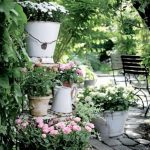Are you looking for landscape ideas for long gardens? Long, narrow outdoor spaces present unique challenges and opportunities for garden design.
In this article, we will explore how to maximize the potential of these elongated areas, from utilizing vertical elements and raised beds to creating functional zones and embracing curves. We will also discuss the importance of choosing the right plants, incorporating focal points, enhancing with lighting and decor, and practical maintenance tips to keep your long garden looking its best.
Long gardens offer a different set of considerations compared to traditional square or rectangular plots. With careful planning and thoughtful design choices, however, they can become stunning outdoor retreats that make the most of their linear layout. In this article, we will delve into various strategies and techniques to help you transform your long garden into a beautiful and functional space that suits your needs and personal style.
Whether you’re starting from scratch with a new long garden or looking for fresh ideas to revitalize an existing one, there are countless ways to create an inviting and dynamic outdoor environment within these distinctive spaces. From maximizing space to selecting the right plants, we’ll cover it all in this comprehensive guide on landscape ideas for long gardens.
Maximizing Space
When designing a long garden, it’s essential to make the most of the available space. One effective way to maximize space is by utilizing vertical elements such as trellises, arbors, and tall planters. These elements not only add visual interest and height to the garden but also create opportunities for growing climbing plants and vines. This can help draw the eye upward, creating a sense of depth in a long, narrow garden.
In addition to vertical elements, raised beds can also be instrumental in maximizing space in a long garden. By elevating planting areas, raised beds provide better drainage and soil structure while also defining different areas within the garden. In long gardens, raised beds can help break up the linear space and create visual interest. They also provide an opportunity to separate different types of plants or create themed planting areas within the landscape.
Another strategy for maximizing space is the use of hanging gardens or vertical planters on walls or fences. This allows for additional planting areas without taking up valuable ground space. By incorporating these techniques into landscape ideas for long gardens, you can make efficient use of space while adding visual appeal and functionality.
| Element | Benefits |
|---|---|
| Vertical elements (trellises, arbors, tall planters) | Provides visual interest and height; creates opportunities for growing climbing plants and vines; draws the eye upward |
| Raised beds | Better drainage and soil structure; defines different areas within the garden; breaks up linear space and creates visual interest |
| Hanging gardens or vertical planters | Adds additional planting areas without taking up valuable ground space |
Creating Zones
Long gardens offer a unique opportunity to create distinct zones within the space, allowing for both variety and functionality. By dividing the garden into different areas, you can make the most of the long, narrow layout and create a more dynamic and interesting landscape. Here are some ideas for creating zones in your long garden:
- Outdoor Dining Area: Set aside a portion of the garden for al fresco dining, whether it’s a patio with a table and chairs or a built-in outdoor kitchen.
- Relaxation Zone: Designate an area for lounging and unwinding, such as a cozy seating nook with comfortable outdoor furniture or a hammock under a shady tree.
- Play Space: If you have children or grandchildren, consider incorporating a play area with swings, a sandbox, or other kid-friendly features.
When creating these zones, it’s important to consider both function and aesthetics. Using different materials, such as decking for the dining area and grass for the relaxation zone, can help visually separate the spaces while also serving their intended purpose. Additionally, planting beds or hedges can act as natural dividers between zones while adding beauty and greenery to the landscape.
In order to enhance the transition between zones in your long garden, consider incorporating pathways that connect each area while also creating visual interest. Curved pathways can be particularly effective in breaking up the linear space of a long garden, guiding visitors through different areas and adding fluidity to the overall design. By thoughtfully dividing your long garden into functional zones, you can make the most of its length while creating an inviting and diverse outdoor space.
Embracing Curves
When designing a long garden, one of the key challenges is to prevent the space from feeling monotonous and linear. One effective way to break up the length and create visual interest is by embracing curves. Curved pathways and planting beds can add flowing lines that soften the linear nature of a long garden, creating a sense of movement and variety.
Curved Pathways
Instead of straight paths that only emphasize the length of the garden, consider incorporating gently curved pathways. Curving paths can create a sense of discovery as they meander through different areas of the garden, leading visitors on a journey through various plantings and features. Using natural materials such as gravel or stepping stones to pave curved pathways can also enhance the organic feel of the design.
Curved Planting Beds
In addition to curved pathways, planting beds with undulating edges can add interest and fluidity to a long garden. Rather than creating strictly linear borders for your flower beds or vegetable patches, consider incorporating gentle curves. This not only breaks up the horizontal lines but also allows for more versatile planting arrangements, including larger focal plants or groupings for added visual impact.
Creating Visual Focal Points
Embracing curves in your garden design not only breaks up the linear space but also provides opportunities for creating focal points. Whether it’s a striking sculpture at a bend in the pathway or a vibrant flower bed at a turning point, using curves strategically can draw attention and add intrigue to different areas within your long garden.
With these strategies in mind, you can use curves in pathways and planting beds to introduce movement, flow, and visual interest to your long garden design. By breaking up the linear space with these organic shapes, you’ll create an inviting landscape that feels dynamic and engaging.
Choosing the Right Plants
When it comes to landscaping ideas for long gardens, choosing the right plants is a crucial step in creating a visually appealing and thriving outdoor space. Long, narrow gardens present unique challenges in terms of sunlight exposure, soil composition, and airflow, so it’s important to select plant species that are well-suited to these conditions.
Consideration of Sunlight Exposure
In long gardens, the areas closest to the house or buildings may receive more shade, while the far end of the garden might get full sun. When choosing plants for a long garden, consider the varying sunlight exposure throughout the space. Shade-loving plants such as ferns and hostas can thrive near shaded areas, while sun-loving varieties like lavender and coneflowers can be planted in sun-drenched spots.
Utilizing Vertical Elements
Incorporating climbing plants and vertical structures such as trellises and arbors can help maximize limited ground space in a long garden. Plants like clematis, jasmine, and ivy can be trained to grow vertically, adding visual interest and texture to walls or fences. Additionally, vertical gardening allows for more planting options without encroaching on walkways or gathering spaces within the garden.
Choosing Low-Maintenance Species
Long gardens often require low-maintenance plant species that can thrive with minimal care. Consider incorporating drought-tolerant plants such as ornamental grasses or succulents, which not only add visual appeal but also require less watering and upkeep.
In addition, selecting native plants that are well-adapted to the local climate and soil conditions can contribute to a healthy and sustainable garden with minimal intervention. By carefully choosing plant species that are suited to the specific challenges of a long garden, homeowners can create a beautiful landscape that thrives in its unique environment.
Incorporating Focal Points
Long gardens can sometimes feel monotonous due to their linear layout, but incorporating focal points can add visual interest and break up the length of the space. There are several ways to achieve this, whether it’s through the use of eye-catching features or strategic placement of decorative elements.
One effective way to draw the eye in a long garden is by adding a striking focal point such as a sculpture, water feature, or a statement plant. These elements create visual interest and serve as a gathering point for the eyes, creating a sense of balance and harmony in the garden. Additionally, strategically placing these focal points at different points along the length of the garden can help create a sense of movement and flow.
Another approach to incorporating focal points in long gardens is through the use of structural elements such as arbors, pergolas, or trellises. These structures not only provide support for climbing plants but also serve as eye-catching features that help break up the linear landscape. By adding vertical elements, it creates layers and depth to the garden while also providing opportunities for vertical gardening.
In addition to physical focal points, lighting can also be used effectively to draw attention to specific areas within the long garden. Properly placed lights can highlight certain plants or architectural features, creating an inviting ambiance and enhancing the overall aesthetic appeal of the space.
| Elements | Examples |
|---|---|
| Focal Points | Sculpture, Water Feature, Statement Plant |
| Structural Elements | Arbors, Pergolas, Trellises |
| Lighting | Spotlights, Uplights |
Lighting and Decor
When it comes to long gardens, creative lighting and decorative elements can play a crucial role in enhancing the overall look and feel of the outdoor space. By strategically incorporating lighting and decor, you can bring personality and charm to what could otherwise be a linear and monotonous landscape. Here are some ideas for adding that extra touch to your long garden:
- Solar-powered string lights: These are an excellent choice for long gardens as they can easily be draped along fences, pergolas, or trellises to add a warm and inviting ambiance. Plus, since they are solar-powered, you don’t have to worry about wiring or electricity.
- Water features: A fountain or small pond can serve as a stunning focal point in a long garden, breaking up the length with visual interest and soothing sound. Consider adding a water feature at the end of the garden to draw the eye and create a sense of depth.
- Decorative screens: Use decorative screens to section off different areas of the garden, creating distinct zones for seating, dining, or gardening. Screens can also provide privacy and serve as a backdrop for climbing plants or vines.
In addition to these ideas, consider incorporating outdoor artwork such as sculptures or colorful mosaics to add personality and flair. By carefully selecting and placing these elements, you can transform your long garden into a captivating outdoor retreat that is both functional and visually appealing.
Maintenance Tips
In conclusion, long gardens present both unique challenges and opportunities for landscaping. By utilizing vertical elements, raised beds, and creating distinct zones within the garden, you can maximize the space and create a more visually appealing and functional outdoor area. Embracing curves in pathways and planting beds can help to break up the linear space of a long garden, adding visual interest and diversity to the landscape.
When selecting plants for a long garden, it is important to choose species specifically suited for long, narrow spaces. Additionally, incorporating focal points such as sculptures or water features can draw the eye and break up the length of the garden. Creative lighting and decorative elements can also enhance the overall aesthetic of a long garden, adding ambiance and style.
Finally, practical maintenance tips are crucial for keeping a long garden looking its best. Regular care and upkeep, including pruning, weeding, and watering, are essential for ensuring that your landscape remains healthy and vibrant. By following these tips and implementing creative landscape ideas for long gardens, you can create an outdoor space that is both beautiful and functional for years to come.
Frequently Asked Questions
How Do You Break Up a Long Narrow Garden?
Breaking up a long narrow garden can be done by creating separate “rooms” or areas within the space. This can be achieved through the use of hedges, pathways, or different types of plants and flowers to visually divide the garden.
How Do You Landscape a Long Narrow Yard?
Landscaping a long narrow yard involves careful planning to make the most of the space. Utilizing vertical elements like trellises or tall plants can help draw the eye upward and create an illusion of more space. Incorporating winding pathways or curved edges can also soften the linear feel of a long, narrow yard.
What Is the Cheapest Way to Cover a Large Garden?
The cheapest way to cover a large garden would be by using materials that are readily available and low-cost, such as mulch, gravel, or wood chips. These options not only provide ground cover but also offer some level of weed control while being budget-friendly.

Welcome to my gardening blog! I am passionate about plants and enjoy sharing my knowledge and experiences with others. In this blog, I will write about everything related to gardening, from tips on how to get started to updates on my own garden projects.





